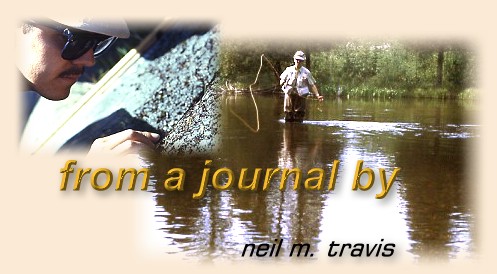Hoot Owl Fishing
By Neil M. Travis, Montana
As I write this piece today at my home near the banks of the
Yellowstone River in Montana the outside air temperature is
approaching 100 degrees, the sun is beating down, and there
is no immediate relief in sight. The State of Montana has
invoked restrictions on most all major trout streams in western
and central Montana, and Yellowstone National Park in Wyoming
has put similar rules into effect on most streams in the park.
In Montana the 'voluntary' stream closures start at 2 p.m. and
extend until midnight until further notice. In Yellowstone
National Park the closures are mandatory and take effect at
2 p.m. until 5 a.m. until further notice. I would anticipate
that other surrounding states in the west would implement
similar measures soon, if they have not already done so.
Unless we experience a major cooling event I would anticipate
that these regulations would remain in effect until early
September in Montana and Yellowstone National Park.
These regulations severely impact angling opportunities but they
do not entirely eliminate them. The first order of business for
the angler is to check ahead. If your fishing trip involves travel
to another area a few phone calls to local fly shops in the area
where you are planning to fish might be time and money well spent.
A check of the Internet web sites maintained by various states will
usually provide up-to-date information on current closures and other
valuable information.
If you are planning on fishing in areas with restrictions imposed
due to low water and high temperatures there are a few things to
remember. High water temperatures have a very adverse affect on
most fish especially cold-water species like trout and salmon.
Warm water holds less oxygen making it more difficult for the
fish to extract the necessary oxygen from the water to sustain
their lives. If the water temperature climbs high enough or
remains at an elevated level for an extended period of time
trout and salmon will begin to die. Due to their size and greater
demand for oxygen larger fish are very susceptible to low oxygen
levels and are among the first to die. Anglers should carefully
monitor the water temperature and stop fishing when temperatures
approach 70 degrees.
Water temperatures are normally the lowest from 5 to 8 a.m. so
anglers should plan to be on the stream during this period of
time. Even at this time anglers should endeavor to play their
catch quickly and release them without removing them from the
water. Barbless hooks and fine mesh or rubber mesh landing nets
will reduce injury to the fish, and enable you to quickly and
safely release your catch. Fish that appear to be having
difficulty breathing should be released in a calm spot near the
shore and monitored by the angler until they swim away under their
own strength. If the fish that you are catching appear to be
particularly stressed you should voluntarily quit fishing to
preserve the resource.
If you are familiar with the water that you are fishing you should
seek out areas where you know that springs or other cold-water
sources enter the main flow. Trout will concentrate in areas
where cold flows lower the water temperatures and increase the
oxygen saturation of the water.
Spring creeks and tail-water fisheries below bottom spill dams
are normally not subject to high water temperatures, and these
offer a viable alternative to the angler. Even these waters are
not completely immune from the affects of hot weather. Hatches
tend to dwindle or become very sporadic, and spinner falls tend
to occur at or near dark or during the very early morning hours
before the sun begins to raise the air temperatures. Bright sunny
days will cause most trout to restrict their feeding to early
morning or late evening after the sun has left the water.
Still waters offer another possibility for anglers. Large bodies
of water offer the angler the opportunity to find areas of cooler
water around spring holes, but anglers will likely have to settle
for fishing with sinking lines since the upper layers of the water
may be too warm to be particularly attractive to trout.
Anglers should remember that the fish are not the only creatures
that are susceptible to the dangers of hot weather. If you are
planning to be on the water during the heat of the day plan on
drinking lots of water to avoid dehydration, and remember the
summer sun can inflict a serious and even life-threatening burn
in a short period of time. Sunscreen should be applied liberally
to exposed skin, long-sleeved shirts, Polaroidized glasses, and
wide-brimmed hats are the order of the day. Sunstroke is a serious
condition, and anglers should be aware that they are very vulnerable.
If you decide to hit your favorite stream consider the fish first.
Trust me, life will go on if you don't go fishing today, but if
your activity destroys the resources it will not matter tomorrow
if the water temperatures drop into the 50's, and the hatches
carpet the surface. ~ Neil M. Travis, Montana/Arizona
From A Journal Archives
|

